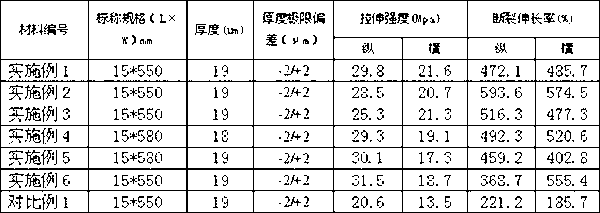Poly(butylene succinate) and preparation method thereof
A technology of polybutylene succinate and butanediol, which is applied in the field of aliphatic copolyesters, can solve the problems of difficult reaction control and degradation of material performance, so as to prolong the maintenance/replacement cycle and reduce the degree of crystallization , the effect of high heat resistance
- Summary
- Abstract
- Description
- Claims
- Application Information
AI Technical Summary
Problems solved by technology
Method used
Image
Examples
Embodiment 1
[0048] 23.0g of 1,4-butanediol, 5.0g of 1,4-cyclohexanedimethanol, and 25.0g of succinic acid were heated up to 210°C under the protection of nitrogen, and 30mg of titanium ethylene glycol was added to maintain the temperature in the reactor. At the same time, the water produced by the reaction is removed by split flow, and the degree of reaction is judged by weighing the water generated by the reaction. When the esterification rate reaches 95%, after the temperature reaches 230°C, add 3.6 mg of phosphorous acid and react for 30 minutes. , and then began to slowly heat up to 245 ° C, gradually increase the degree of vacuum, keep the temperature constant, keep the pressure in the kettle below 80 Pa, and react for 3.5 hours. The reactor was flushed with nitrogen to normal pressure, 0.05 g of 1-(3-dimethylaminopropyl)-3-ethylcarbodiimide compound was added, stirred for 5 minutes, and the obtained product was obtained.
[0049] The relevant indicators of the product were obtained:...
Embodiment 2
[0051]Put 38.0g of 1,4-butanediol, 5.0g of 2,2,4,4-tetramethyl-1,3-cyclobutanediol, 25.0g of succinic acid, under the protection of nitrogen, raise the temperature to 200°C, add Titanium glycolate 30mg, maintain the temperature in the reactor at 200°C, and remove the water produced by the reaction by splitting, and judge the degree of reaction by weighing the water generated by the reaction. When the esterification rate reaches 95%, lower the temperature to 230°C Finally, add 3.6mg of phosphorous acid, react for 30 minutes, then start to slowly raise the temperature to 245°C, gradually increase the degree of vacuum, keep the temperature constant, keep the pressure in the kettle below 80Pa, and react for 3.5 hours. The reactor was flushed with nitrogen to normal pressure, 0.05 g of 1-(3-dimethylaminopropyl)-3-ethylcarbodiimide was added, stirred for 5 minutes, and the obtained product was obtained.
[0052] The relevant indicators of the product were obtained: viscosity 1.33dL / ...
Embodiment 3
[0054] Put 33.0g of 1,4-butanediol, 5.0g of 2,2,4,4-tetramethyl-1,3-cyclobutanediol, 25.0g of succinic acid, under the protection of nitrogen, raise the temperature to 190°C, add Titanium glycolate 30mg, maintain the temperature in the reactor at 190°C, and remove the water produced by the reaction by splitting, and judge the degree of reaction by weighing the water generated by the reaction. When the esterification rate reaches 95%, lower the temperature to 230°C Finally, add 5.0 mg of phosphorous acid, react for 30 minutes, then start to slowly raise the temperature to 245°C, gradually increase the degree of vacuum, keep the temperature constant, keep the pressure in the kettle below 80Pa, and react for 3.5 hours. The reactor was flushed with nitrogen to normal pressure, 0.08 g of 1-(3-dimethylaminopropyl)-3-ethylcarbodiimide was added, stirred for 5 minutes, and the obtained product was obtained.
[0055] The relevant indicators of the product were obtained: viscosity 1.33d...
PUM
 Login to View More
Login to View More Abstract
Description
Claims
Application Information
 Login to View More
Login to View More - R&D
- Intellectual Property
- Life Sciences
- Materials
- Tech Scout
- Unparalleled Data Quality
- Higher Quality Content
- 60% Fewer Hallucinations
Browse by: Latest US Patents, China's latest patents, Technical Efficacy Thesaurus, Application Domain, Technology Topic, Popular Technical Reports.
© 2025 PatSnap. All rights reserved.Legal|Privacy policy|Modern Slavery Act Transparency Statement|Sitemap|About US| Contact US: help@patsnap.com

